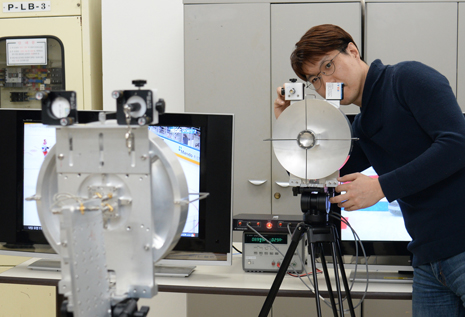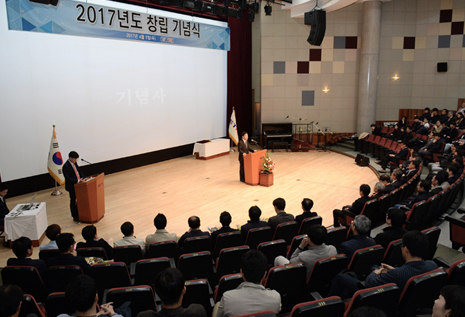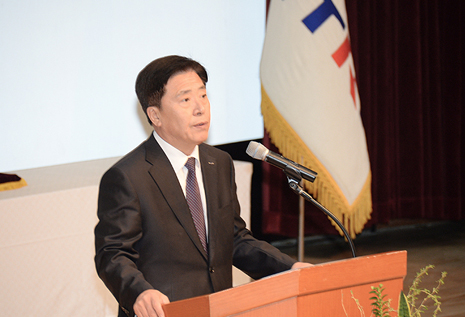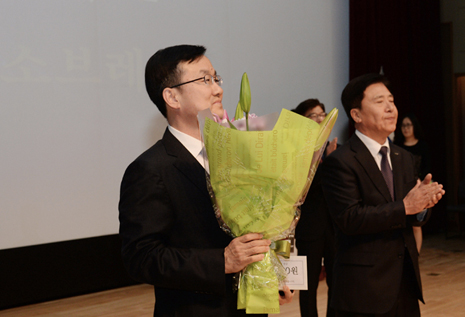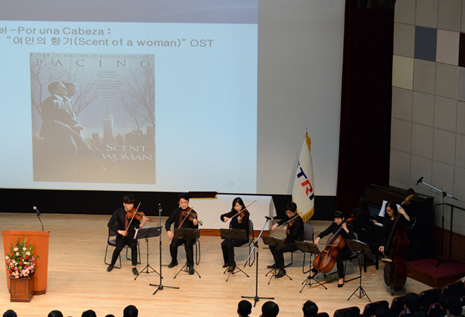
Electrodes Realize Dream Display
ETRI researchers have successfully developed a next-generation display made with electrodes using graphene, often dubbed a new dream material, replacing indium tin oxide (ITO), which has been used for the electrodes of existing OLED displays.
This new technology is expected to help realize thin, flexible displays by combining graphene and the flexible display substrate. It will also be widely used for producing wearable devices requiring high flexibility.
The key characteristic of this technology is that is addresses the issue of easily breakable glass by replacing the widely used ITO with graphene. A transfer technology was also developed to apply the enlarged substrate to graphene growth technology and transparent OLED electrodes. The researchers became the world’s first to develop a micro-patterning process, which is a critical requirement for display processing.
ETRI used this technology to light a 370mm x 470mm panel, the largest available in the world as an OLED panel using a graphene-based electrode. At the end of March, the institute’s achievement was presented through a paper and a demonstration that was applauded at Graphene 2017, the world’s largest conference on graphene, held in Barcelona, Spain.
Nurture Creative Research
ETRI launched its first AOC (Autonomous Open Community) in April 2016 as a spontaneous research group to communicate with a number of researchers within the institute and share ideas for common interests. A total of 43 AOCs have been organized within ETRI with over 260 participants, shifting the paradigm for research culture.
Currently, AOCs meet up weekly or biweekly to present and discuss ideas and share information. The topics covered by the AOCs include “Convergent ICT for the socially underprivileged,” “Becoming a brain science specialist comparable to medicine graduates within six months,” and “Algorithms of brain engineering.”
The research communities do not evaluate research outcomes or performance but rather they spontaneously gather and share and study knowledge from a range of scientific areas.
Some of the popular issues are studying brain science lectures; self-driving drones; convergent ICT for the socially underprivileged; energy informatics; ETRI’s self-driving vehicle (taxi); probability-based machine learning; VIVA silver (with media/transmission technology), and future-oriented telecommunications.
Going beyond the framework of AOCs, ETRI biannually holds an AOC Fair to offer an opportunity for research communities to share their interests and topics as well as novel ideas for research. The first fair was held in January 2017, encouraging those who have not joined any AOC to take interest in the new form of research communities.
ETRI anticipates that AOCs will suggest a number of creative projects to form an active and dynamic research culture. In addition, the institute hopes that the research communities will serve as a venue for all members of government-funded research institutes as well as ETRI to explore multiple interests, including the role of science and technology to respond to national disasters.
of Limited Frequency Resources
A research team at ETRI has developed technology to transmit data through multilayered, revolving frequency. This technology results in tripled efficiency of the frequency compared to the existing technologies, which will significantly help to utilize the limited frequency resources.
The new technology was conceived on the basis of the fact that, just as the Earth revolves around the sun, radio waves move around a specific orbit as well. This is known as the OAM (orbital angular momentum). The researchers explain that the technology takes advantage of this characteristic that had remained unknown. It had been believed that radio waves move only vertically or horizontally. This led to data transmission in those two directions, resulting in a low frequency efficiency. The recently developed technology enhances the efficiency by transmitting different types of data through the same frequency based on the different shapes of radio energy.
In particular, the technology demonstrates the best performance in the bandwidth of 30GHz-300GHz, a millimeter bandwidth that is called an unexplored frequency resource for the future. As a result, it will be significantly useful in establishing an integrated 5G mobile communication network.
ETRI is planning to develop various technologies for commercialization in phases based on the original patents in its possession, such as flat-type reflector antennas, technology for bulk data telecommunications, and high-resolution radar technology.
Celebrate Its 41stAnniversary
On April 5, ETRI held a ceremony in the auditorium to celebrate its 41stanniversary with participation by al lmembers with in the institute.
The event opened with an awards ceremony for ETRI Technology Awards, ETRI Researcher of the Year, and other rewards for outstanding researchers, followed by a speech by the ETRI President, a congratulatory performance by an orchestra, and members singing a chorus of the institute’s anthem.
The ETRI Technology Awards went to Exobrain, and Dr. Hwi-yong Kim, a principal researcher, was awarded ETRI Researcher of the Year.
In his commemorative speech, President Sanghoon Lee noted, “ETRI has to grow into a hub for openness, sharing, and collaboration in partnership with businesses of all sizes as well as universities.”








